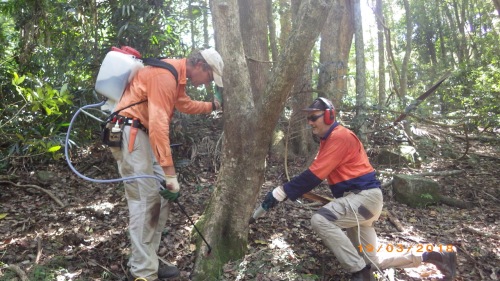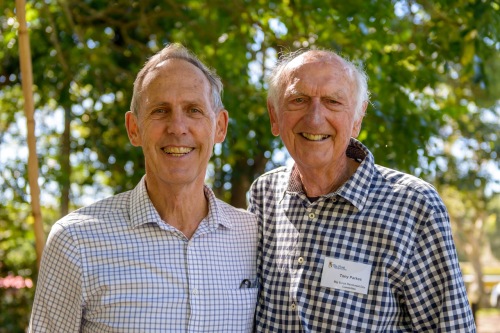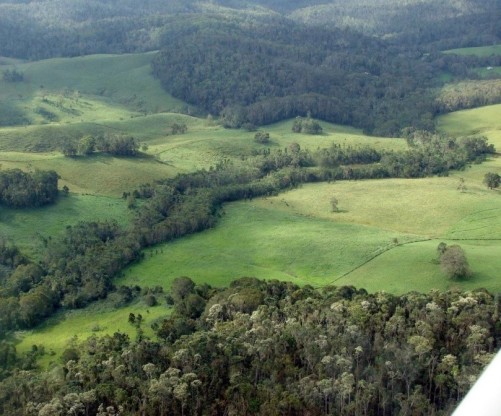Tony Parkes, Mark Dunphy, Georgina Jones and Shannon Greenfields
[Update of EMR feature article: Parkes, Tony, Mike Delaney, Mark Dunphy, Ralph Woodford, Hank Bower, Sue Bower, Darren Bailey, Rosemary Joseph, John Nagle, Tim Roberts, Stephanie Lymburner, Jen Ford and Tein McDonald (2012) Big Scrub: A cleared landscape in transition back to forest? Ecological Management & Restoration 12:3, 212-223. https://doi.org/10.1111/emr.12008]
Key words: Lowland Subtropical Rainforest, ecological restoration, seed production, landholder action, corridors

Figure 1a. Rainforest regenerators undertake camphor injection, leaving bare trees standing creating light and an opportunity for seed in the soil to naturally regenerate. (Photo © Envite Environment)

Figure 1b Aerial photo showing camphor conversion by injection
(Photo © Big Scrub Regeneration Pty. Ltd.)
Introduction. The Big Scrub, on the NSW north coast, was once the largest tract of Lowland Subtropical Rainforest (LSR) in Australia. It was reduced to less than 1% of its original extent by he end of hte 19th century after clearing for agriculture. Big Scrub Landcare (BSL) is a non-profit organisation dedicated to improving the long-term ecological functionality of what remains of this critically endangered ecosystem – lowland subtropical rainforest. Our 2012 EMR feature reported on remnant restoration and revegetation works overseen by BSL to 2012. At that time, 68 remnants were identified as significantly affected from the impacts of environmental degradation including weed invasion and cattle access. These remnants had been undergoing treatments, with 20 substantially recovered and on a ‘maintenance’ regime. Approximately 900,000 trees had been planted to establish 250 ha of young diverse well-structured rainforest. A comparatively small area of forest dominated by the highly invasive exotic, Camphor Laurel (Cinnamomum camphora) (Camphor), which has colonised much of the Big Scrub landscape had been converted to early phase LSR by skilled removal of a range of weeds and facilitating natural regeneration.
Progress since 2012. Substantial progress in restoring critically endangered lowland subtropical rainforest in the Big Scrub has been achieved over the past seven years in the following areas.
- Assisted regeneration of remnants has continued and become more focused
- Re-establishment of LSR through plantings has expanded
- Camphor conversion has developed in scale and techniques
- Greater security of funding has been achieved
- Community engagement has greatly improved and expanded
- Genome science is being applied to produce seed with optimal genetic diversity for rainforest restoration.
Assisted regeneration of remnants. This work continues to be the major focus of on-ground restoration work. About 2000 regenerator days (9 years Full Time Equivalent) of work has been undertaken in 45 remnants. BSL’s remnant restoration program has become more strategic, with more focus on Very High Conservation Value (VHCV) remnants, particularly those in the NSW National Parks Estate, including the VHCV sites in Nightcap National Park (NP) including Big Scrub Flora Reserve, Minyon Falls and Boomerang Falls; Andrew Johnston’s Scrub NR; Snow’s Gully Nature Reserve (NR); Boatharbour NR; Victoria Park NR and Davis Scrub NR, plus the Booyong Flora Reserve. Rehabilitation work at these sites is prioritised in the major new four-year Conservation Co-funding project funded jointly by BSL and the NSW government’s Saving our Species program. Big Scrub Foundation (BSF) funding has enabled BSL to continue maintenance work in remnants that have reached or are approaching the maintenance stage.
Monitoring outcomes has become more rigorous and has demonstrated ongoing improvements in vegetation structure, with decreasing levels of weed invasion and improvements in native species cover.
BSL’s partner Envite Environment, with some assistance from BSL, is creating an important linkage between Nightcap NP and Goonengerry NP by the restoration of rainforest through the progressive removal of weeds that had dominated the 80 ha Wompoo/Wanganui corridor between these two NPs.
Re-establishment of rainforest by planting. The area of LSR is being re-established by planting on cleared land has also continued to expand. In the last 7 years more than 0.5 million rainforest trees have been planted in the Big Scrub region, contributing to the restoration of another 175 ha of LSR, expanding total area of re-established rainforest by another 13%. While landscape-scale landholder driven work is inevitably opportunistic rather than strategic, the establishment of new patches of LSR enhance valuable stepping-stone corridors across the Big Scrub. Since 2012 the number of regenerators working fulltime in the Big Scrub region has increased by approximately 50%. Another trend that has strengthened in the last 7 years is that larger plantings are now being carried out by well-resourced landowners. This is accounting for about 40% of the annual plantings. Offsets for residential development account for another 40% of trees planted. The remaining 20% is made up by small landowners, cabinet timber plantations, large-scale landscaping, and other planting of Big Scrub species. This is a significant change from the more dominant grant-based small landowner/Landcare group plantings prior to 2012.
Camphor conversion. Larger areas of Camphor forest are being converted to rainforest, with project areas increasing substantially from less than a hectare to ten and twenty hectares. BSL estimates that more than 150 ha of Camphor forest are currently under conversion. Some landowners underake camphor injection which leaves bare trees standing, creating light and an opportunity for existing native seedlings and seed in the soil (or seed dropped by perching birds) to naturally regenerate (Fig 1). Others are choosing the more expensive option of physically removing the Camphor trees and carefully leaving the rainforest regrowth (Fig 2). Improved techniques and landholder capacity building continue to progress and camphor conversion is now a significant component of rainforest restoration.
BSL alone is facilitating the conversion of almost 40 ha of Camphor forest to LSR funded by two 3-year grants from the NSW Environmental Trust, together with contributions from the 19 landholders involved in these projects. The ecological outcomes being achieved are significant and less costly than revegetation via plantings.

Figure 2a. Camphor forest under conversion using heavy machinery leaving rainforest regrowth intact (Photo © Big Scrub Landcare)
Greater security of funding. Australian Government funding for biodiversity conservation is at a very low level. Competition for existing NSW state government funding is increasing. BSL therefore has continued to develop new strategies for fund raising to ensure continuity of its long-term program for the ecological restoration of critically endangered LSR in the Big Scrub and elsewhere. Ongoing funding of at least $150,000 annually is needed to ensure the great progress made over the past 20 years in rehabilitating remnants is maintained and expanded to new areas of large remnants. These funds finance weed control and monitoring; weeds will always be a part of the landscape and an ongoing threat to our rainforest remnants.
Establishment of the Big Scrub Foundation in 2016 was a major development in BSL’s fund raising strategy. The Foundation received a donation of AUD $1M to establish a permanent endowment fund that is professionally invested to generate annual income that helps finance BSL’s remnant care program and its other activities. Generous donors are also enabling the Foundation to help finance the Science Saving Rainforest Program.

Figure 3a. Australian gardening celebrity Costa Gregoriou at a Big Scrub community tree planting (part of the 17th annual Big Scrub Rainforest Day) in 2015 (Photo © Big Scrub Landcare)

Figure 3b. Founder of the Australian Greens political party Bob Brown and Dr. Tony Parkes at the 18th annual Big Scrub Rainforest Day in 2016. (Photo © Big Scrub Landcare)
Community engagement. The Big Scrub Rainforest Day continues to be BSL’s major annual community engagement event, with the total number of attendees estimated to have exceeded 12,000 over the past 7 years; the 2016 day alone attracted more than 4000 people (Fig 3). Every second year the event is held at Rocky Creek Dam. A new multi-event format involving many other organisations has been introduced on alternate years.
BSL’s Rainforest Restoration Manual has been updated in the recently published third edition and continues to inform and educate landowners, planners and practitioners.
BSL in partnership with Rous County Council produced a highly-commended book on the social and ecological values of the Big Scrub that has sold over 1000 copies. BSL’s website has had a major upgrade: its Facebook page is updated weekly; its e-newsletter is published every two months. BSL’s greatly improved use of social media is helping to raise its profile and contribute to generating donations from the community, local businesses and philanthropic organisations to fund its growing community education and engagement work and other activities.
Science saving rainforests program. BSL, the Royal Botanic Gardens Sydney, the BSF and their partners have commenced an internationally innovative program to apply the latest DNA sequencing and genome science to establish plantations to produce seed of key species with optimal genetic diversity for the ecological restoration of critically endangered lowland subtropical rainforest. This program will for the first time address the threat posed by fragmentation and isolation resulting from the extreme clearing of Australia’s LSR, which is estimated to have resulted in the destruction of 94% of this richly biodiverse Gondwana-descended rainforest.
Many key LSR species are trapped in small populations in isolated remnants that lack the genetic diversity needed to adapt and survive in the long term, particularly faced with climate change Necessary genetic diversity is also lacking in many key species in the 500 ha of planted and regrowth rainforest. The first stage of the program, already underway, involves collecting leaf samples from approximately 200 individual old growth trees in 35 remnant populations across the ranges of 19 key structural species of the ‘original’ forest. DNA will be extracted from the leaf samples of each species and sequenced. The latest genome science will be applied to select the 20 individual trees of each species that will be cloned to provide planting stock with optimal genetic diversity for the establishment of a living seed bank in the form of a plantation that will produce seed for use in restoration plantings. As the individual trees in the restoration plantings reproduce, seed with appropriate genetic diversity and fitness will be distributed across the landscape. The project focuses on key structural species and thus helping the survival of Australia’s critically endangered Lowland Subtropical Rainforest in the long term.
Lessons learned and current and future directions. A key lesson learned some five years ago was that BSL had grown to the point where volunteers could no longer manage the organisation effectively. BSL took a major step forward in 2015 by engaging a part-time Manager, contributing to BSL’s continuing success by expanding the scope, scale and effectiveness of its community engagement activities and improving its day to day management.
The principal lesson learned from BSL’s on-ground restoration program is to focus on rehabilitation of remnants and not to take on large planting projects, but rather support numerous partnered community tree planting events. Large grant-funded multi-site tree planting projects are too difficult to manage and to ensure landholders carry out the necessary maintenance in the medium to long term.
Acknowledgements. BSL acknowledges our institutional Partners and receipt of funding from the NSW government’s Saving our Species program, NSW Environmental Trust and Big Scrub Foundation.
Contact: Shannon Greenfields, Manager, Big Scrub Landcare (PO Box 106, Bangalow NSW 2479 Australia; . Tel: +61 422 204 294; Email: info@bigscrubrainforest.org.au Web: www.bigscrubrainforest.org.au)
















